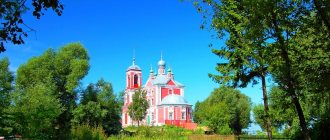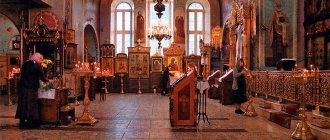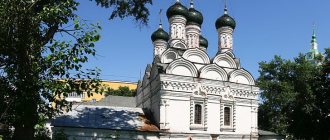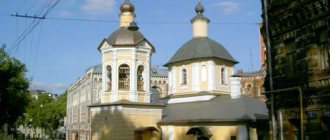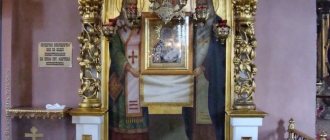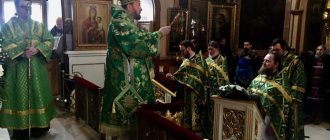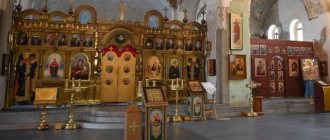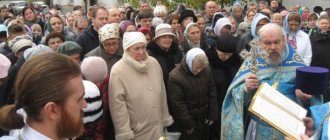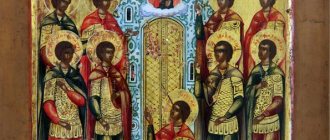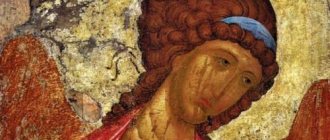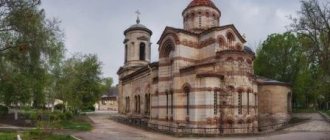History of the Church of the Forty Martyrs of Sebaste in Spasskaya Sloboda
In the winter of 320 AD, the pagan military leader Agricola drove 40 Cappadocian warriors, who professed the Christian faith, into icy water. And in order to get rid of the torture, they seemed to demand little: to perform a pagan ritual and make a sacrifice to idols. Deny faith in Christ. And to make it even more convincing, the pagans melted a bathhouse on the shore. The freezing warriors spent the night in prayer, but one of them could not stand it and denied. But as soon as he crossed the threshold of the hot bath, he immediately fell dead. And yet exactly forty martyrs remained - they were voluntarily joined by the prison guard, who observed the torture and saw a miraculous light appear over the heads of the praying soldiers. The next morning, the guards, finding the disobedient warriors alive, killed them. Three days after their death, Bishop Peter of Sebastia had a vision of the death of 40 Sebastian martyrs, after which he collected their remains and buried them. And since then, the Holy Forty Martyrs of Sebaste have been revered as the patrons of warriors. One thousand three hundred years later, in 1645, opposite the Novospassky Monastery, in Spasskaya Sloboda, a stone church was erected - instead of a wooden one - in honor of the Forty Martyrs of Sebaste, the only church in their honor in Moscow. Small beautiful parish church. And it would not differ in any way from other temples if another feat had not been accomplished within its walls. A feat that, perhaps, can be placed next to the feat of the forty martyrs. In 1812, the 66-year-old rector of the temple, Pyotr Gavrilovich Velyaminov, was killed by French marauders. He was killed on the second day after the French invasion of Moscow. He refused to give the place of storage of valuable church utensils to the looters, and for this he was subjected to severe torture. Mortally wounded, chopped with sabers and bayoneted, Father Peter lay near the church all night. And on the morning of September 3, a French officer, taking pity on the suffering of Pyotr Gavrilovich, shot the martyr. In memory of his feat, after the liberation of Moscow, a gilded plaque was nailed to the temple wall outlining the circumstances of his death. So, when you have to visit the Church of the Forty Martyrs of Sebaste, remember another martyr, a hero of the Patriotic War of 12, a simple priest Pyotr Gavrilovich Velyaminov.
Website address: https://40much.ru/
Patronal feast day in honor of the 40 Martyrs of Sebaste
On March 22, 2021, the parish of St. George the Victorious celebrated the patronal feast of the crypt church of the Forty Martyrs of Sebaste. On this day, the Liturgy of the Presanctified Gifts was led by the Head of the Don Metropolis, Metropolitan of Rostov and Novocherkassk Mercury. His Eminence was served by the rector of the church, Archpriest Valery Voloshchuk, the dean of the parishes of the Western District, Priest Alexander Litvinenko, and clergy of the Rostov-on-Don diocese. At the end of the Liturgy, Vladyka Metropolitan performed a prayer service before the icon of the Forty Martyrs of Sebaste.
Then the rector of the church, Archpriest Valery Voloshchuk, addressed the Head of the Don Metropolis, thanking His Eminence for performing the service on the throne day and for taking care of our parish. Metropolitan Mercury greeted those praying on the day of remembrance of the Forty Martyrs of Sebaste and in his archpastoral speech addressed the meaning of the Gospel parable about the vineyard workers who received equal pay, who began their work at the beginning of the day and in its last hours.
“Concluding this parable, the Lord says: “The last will be like the first, and the first like the last.” What is its essence? And the fact is that through the owner and through his relationship with the workers of the vineyard, we understand God’s attitude towards the human race. Very often we, as Christians, begin to enter into a kind of bargaining with the Lord. So we will fast, pray, give alms, work, and You, be kind, provide us with the Kingdom of Heaven. Who hasn't had such thoughts? There are hardly a few. And when we see people who, perhaps, lived their entire lives in idleness, outside the Church and outside of work, but at the end of their journey they repented, showed love for the Lord, so sincere and so high, which even those who worked from the first hour , and did not even think, our heart is broken. But God loves everyone equally, and does not give us this or that blessing for our labors and makes us worthy of the Kingdom of Heaven, but sends us all this only out of His ineffable and great love and mercy for us. And he has mercy on everyone equally: those who worked from the very first hour, and those who turned to Him at their last hour.
During the days of Holy Great Lent, this parable is very important for us. We need to understand that God has mercy on us not for our labors, not for our exploits, but out of His inexpressible love. We cannot earn the Kingdom of God. We should be eager to serve the Lord, and in this service we should not think about how much we will be paid.
After the Liturgy, the sisters of mercy treated all those gathered to delicious borscht and larks, which are traditionally baked in Rus' on the day of remembrance of the 40 martyrs. And they held another “Your Mite for Life” campaign, collecting another 300 signatures for a ban on abortion.
We express our heartfelt gratitude to the Mobile Special Purpose Detachment of the Russian Guard (location in Rostov-on-Don) for the provision of a field kitchen; Viktor Ivanovich Chutskov, under whose strict guidance 130 liters of borscht were cooked and 150 liters of tea were prepared; the Samarin family, who donated larks for the holiday; the florists of our workshop, who magnificently decorated the crypt temple of the 40 Martyrs of Sebaste; and to everyone, everyone, everyone who participated in cleaning and preparing the temple for the holiday. God bless you!
Story
Presumably, back in the 16th century there was a wooden church on this site. In 1644-1645, a stone one was erected to replace it[3]. The temple was rebuilt several times. Now the building includes the temple itself with an apse, an adjacent refectory with two chapels in the name of St. Nicholas the Wonderworker and in the name of the apostles Peter and Paul. The refectory is connected by a passage to the bell tower. The low double-height quadrangle and semicircular apse have been preserved from the original building, but their decor has been completely lost. The refectory was probably built in 1698; it was rebuilt twice in the 19th century. The first time the funds were donated by the merchant P. Ya. Maslov, the work was carried out in 1831-1838. The refectory was rebuilt for the second time in 1878 by the architect Pyotr Campioni with the money of F. M. Strizhenov; the surviving hemispherical roof of the church dates back to the same time, as well as the decoration of the facades in the spirit of eclecticism, consisting of plaster cornices and “framed” frames of rectangular windows. On the side facades of the refectory there were pilasters dividing the planes of the walls, and the central parts of the side facades were crowned with small attics[4].
In 1801[2][Note 1] a two-tier Empire bell tower was erected, the lower tier was decorated with paired pilasters. The narrow passage connecting the bell tower and the refectory later disappeared under new side extensions.
In 1812, the temple was looted by Napoleonic soldiers. Abbot Pyotr Venyaminov managed to hide particularly valuable church utensils and, even under severe torture, refused to reveal the location of the storage of the shrines. He was killed by the French. The martyrdom of the rector of the temple was immortalized with a memorial plaque on the wall of the temple[1].
The church is surrounded by a fence erected in the 19th century.
In 1925, the patronal feast of the Forty Martyrs of Sebaste, March 22, fell on the Sunday of the Week of the Cross. Patriarch Tikhon performed the festive liturgy. This was one of the last services he performed - on April 7, 1925, Patriarch Tikhon died[1].
In 1932, the temple was closed by the Soviet authorities[3], the bell tower was partially cut down (the lower tier and a small half-tier were left). Since 1992, regular services have been held in the temple. In 1993, the temple was transferred to the community of believers, after which restoration work was carried out and the bell tower was restored[4], a belfry with 12 bells was installed on it, the historical stone fence around the temple was restored, the entrance lobby with iron shutters-doors, a canopy on the columns was recreated. foundations, the white stone plinth was restored, a new roof was laid, and the foundations were strengthened. Repair work was carried out in all chapels, altars, and the refectory[1].
The great consecration of the temple was performed on March 10, 2021 by Patriarch Kirill of Moscow and All Rus'. Three altars were consecrated: the central one - in honor of the Forty Martyrs of Sebaste; northern - in honor of St. Nicholas the Wonderworker; the southern one is in honor of the holy supreme apostles Peter and Paul[1].
- Church in 1884. Photo by Nikolai Naydenov
- The temple in 2008, before the restoration of the bell tower
- Altar barrier of the northern aisle
- Iconostasis of the main altar
- Altar barrier of the southern aisle
Myasnitskaya Sloboda
Myasnitskaya Street recorded the name of Myasnitskaya Sloboda, where the Tsar’s butchers lived. Cattle were driven to Moscow in droves - large herds. At the same time, it was required that the herds, passing through cities and villages, would certainly follow bypass roads and, only in the absence of the latter, could pass through populated areas without stopping in them. This practice existed until the second half of the 19th century, when in 1886 it was prescribed that livestock should be transported to slaughter sites exclusively by rail. Since the amount of meat obtained at slaughter differs significantly from the total weight of the animal (the so-called slaughter weight), the sale of livestock required a certain ability to estimate the weight of the animal. Herders and butchers did this by sight and rarely made mistakes, since they knew well the characteristics of the most common breeds of livestock.
The center of the settlement was the Church of St. Nicholas the Wonderworker, documented since 1620, although there is no doubt that it existed already in the 16th century. The church was demolished in 1928 and now the State Statistics Committee building is located in its place (Myasnitskaya St., 39).
